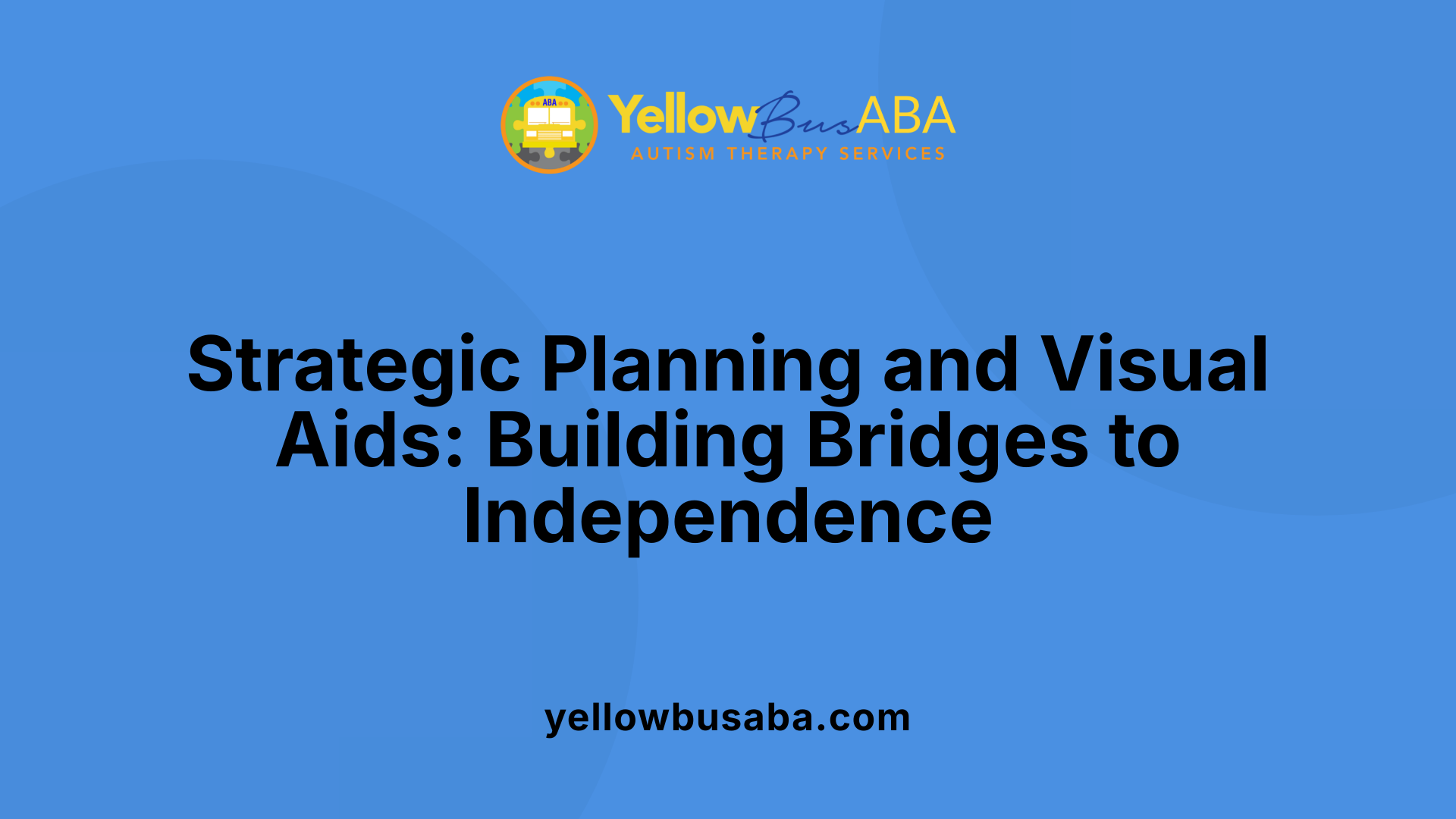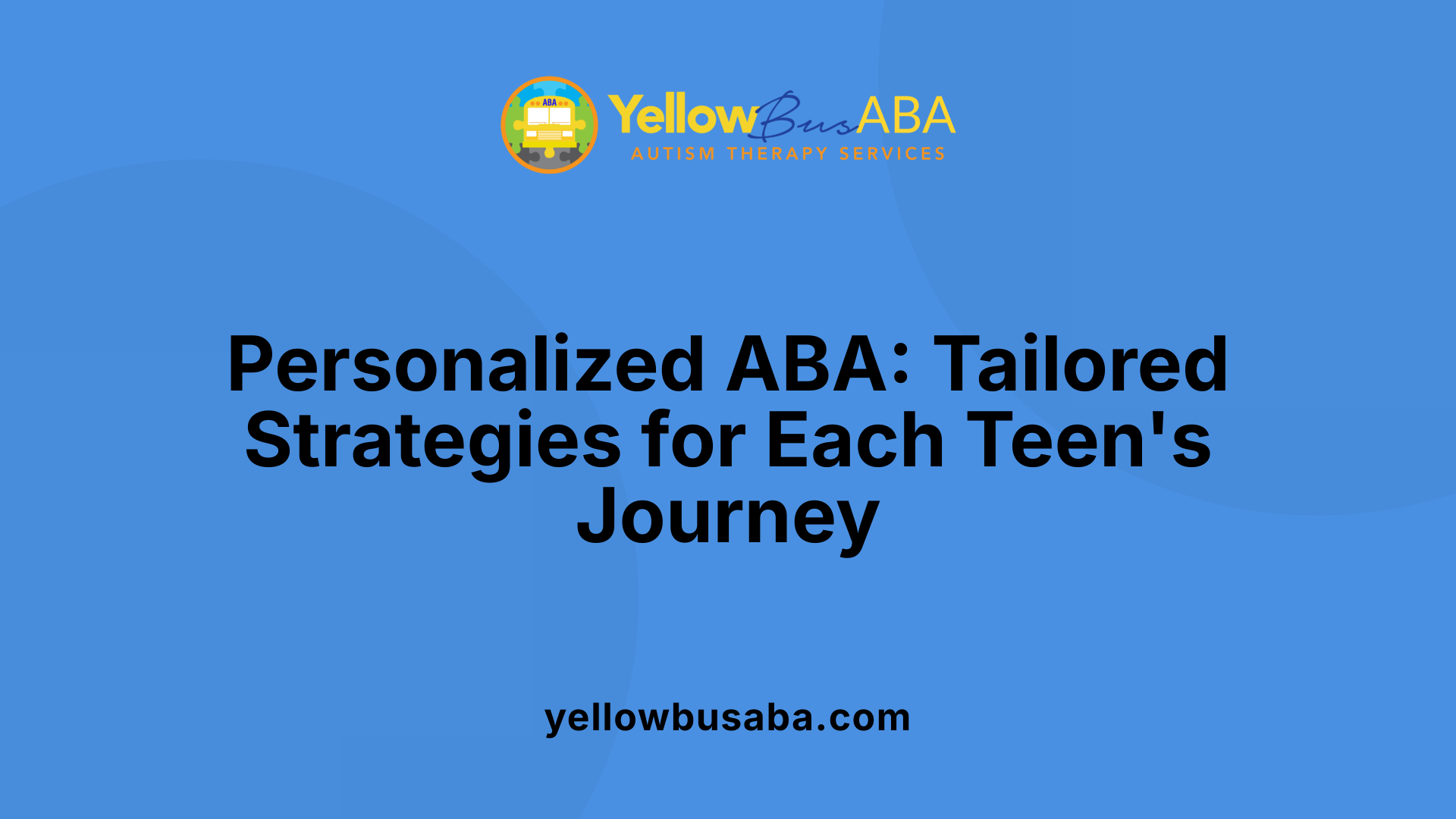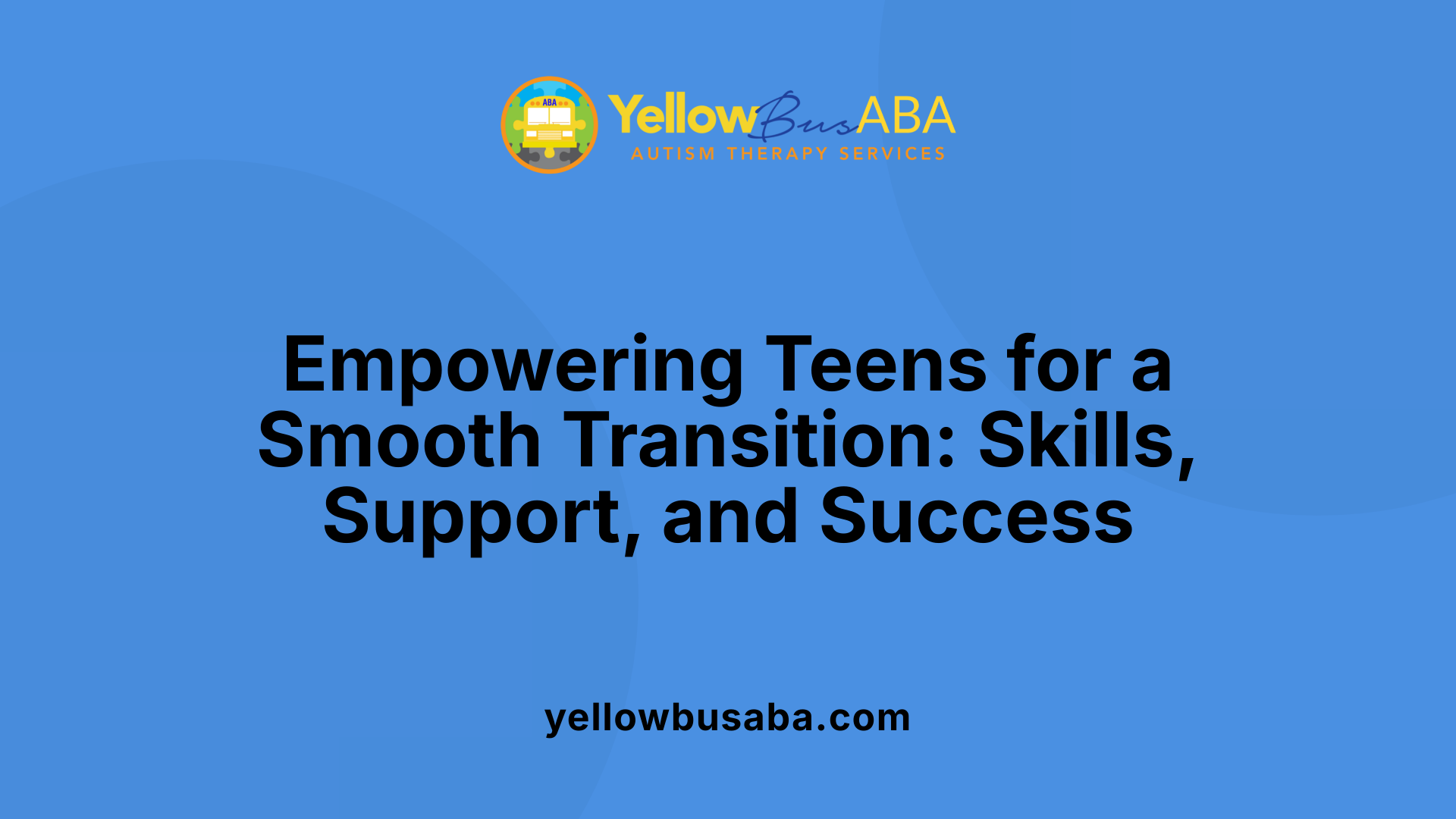Understanding the Role of ABA in Adolescent Development
School and life transitions present unique challenges for adolescents with autism. Dedicated Applied Behavior Analysis (ABA) therapy offers tailored interventions that develop essential skills, promote independence, and smooth the path into adulthood. This article explores how ABA supports adolescents during these critical phases, emphasizing customized strategies, planning tools, and collaboration with families and educators.
How ABA Develops Skills for School Readiness and Transition to Adulthood

How does ABA therapy develop skills to support school readiness and transition to adulthood?
ABA therapy plays a vital role in preparing autistic teens for both school success and lifelong independence. It focuses on developing essential skills such as communication, social interaction, emotional regulation, and self-help abilities.
To enhance communication skills, ABA employs techniques like visual supports, modeling, and reinforcement to teach expressive and receptive language. Social skills are fostered through peer interaction exercises, role-playing, and group activities, helping teens navigate social settings confidently.
Emotional regulation is another critical focus, where teens learn to manage stress, recognize emotions, and apply coping strategies. ABA helps develop self-help skills such as personal care, cooking, money management, and transportation—basic routines that support daily independence.
The approach is highly individualized. Therapists conduct assessments to identify strengths and challenges, designing tailored intervention plans. Using structured routines, visual aids, and real-world practice, ABA reinforces skills in familiar and community environments.
Collaboration with educational teams is crucial. Updating Individualized Education Programs (IEPs) and training teachers ensures that learning and support are consistent across settings. This teamwork helps reinforce skills and sets clear goals for the transition process.
For adolescents, ABA extends beyond academic skills to include vocational readiness and self-advocacy. Transition planning often begins around age 14, focusing on skills like workplace readiness, higher education, and self-management.
By integrating these strategies, ABA supports autistic teens in gaining independence and confidence, paving the way for a successful transition from school to adulthood.
Planning Tools and Approaches Supporting Effective Transitions

What planning tools and approaches in ABA support effective transition for adolescents?
ABA therapy incorporates various tools and strategies that are crucial for helping teens with autism transition smoothly into adulthood. Personalized planning tools like individualized transition plans set clear, actionable goals aligned with the teen’s interests and future aspirations. Visual aids, such as visual schedules and social stories, help teens understand upcoming changes and routines, reducing anxiety and building coping skills.
Social stories describe specific scenarios and appropriate responses, making abstract concepts concrete and approachable. These tools are complemented by targeted interventions that focus on developing essential skills, including communication, self-care, social interaction, and daily living activities like cooking, money management, and using transportation.
Progress monitoring is a vital part of ABA, where data is collected regularly to evaluate the effectiveness of the interventions. Based on this information, therapists can make timely adjustments, ensuring that the programs stay aligned with the teen’s evolving needs and transition goals.
Community-based learning activities are integrated into therapy to foster independence. These include vocational training, supermarket shopping, using public transit, and engaging in group community events. Such experiences help teens generalize skills learned in therapy to real-world settings.
Parental involvement and collaboration with schools and community programs enhance the success of transition plans. Families are encouraged to reinforce skills at home and advocate for their teens’ needs, creating a consistent pathway to independence.
| Tool/Strategy | Purpose | Specific Activities |
|---|---|---|
| Visual Schedules | Prepare teens for daily routines and changes | Day-to-day planning, event countdowns |
| Social Stories | Teach social rules and expectations | Scenarios like shopping, using a phone |
| Transition Plans | Set personalized roadmaps for future skills | Education, employment, community participation |
| Community-based Learning | Practice real-world skills in natural environments | Shopping, transportation, work experience |
| Progress Monitoring | Track growth and guide therapy adjustments | Data collection and review sessions |
These tools and approaches work together to support autism teens in gaining independence, improving social and emotional skills, and preparing for adult life. Regular collaboration among therapists, families, and educators is essential to customize and optimize transition strategies, ensuring each teen’s journey toward adulthood is confident and positive.
Customization of ABA for Adolescents Facing Transition Challenges

How is ABA therapy customized for adolescents facing transition challenges?
ABA therapy for teenagers who are preparing for adulthood is designed to be highly personalized. It begins with a detailed assessment that identifies each teen’s strengths, challenges, and specific goals related to independent living, employment, education, and social skills.
Based on this evaluation, therapists create a tailored intervention plan. This plan includes evidence-based techniques like visual supports, social skills training, and community outings to help teens practice real-world skills. For example, a teen may learn grocery shopping, using public transportation, or practicing job interview skills.
Behavior management strategies such as positive reinforcement and modeling are central. These methods encourage desirable behaviors like emotional regulation and decision-making. Tasks are often broken down into smaller steps using task analysis, making learning manageable and engaging.
The therapy is not static. Regular monitoring helps therapists assess progress and make necessary adjustments to ensure goals are being met. This ongoing process allows for the generalization of skills across different environments—at home, school, or in the community.
Family involvement is crucial. Caregivers participate actively in planning, practicing, and reinforcing skills outside therapy sessions. They collaborate with therapists to set realistic, meaningful goals aligned with each teen’s future aspirations.
Overall, this individualized approach aims to support teens in gaining independence and confidence, easing their transition into adult roles, and preparing them for a successful, self-sufficient future.
Support Services and Therapies Facilitating Transition

What support services and therapies aid in easing the transition for autistic adolescents?
Supporting autistic teens as they transition into adulthood requires a comprehensive approach involving various services and therapies tailored to their unique needs. Educational supports such as individualized education programs (IEPs) play a central role in this process. IEPs are customized plans developed collaboratively by educators, therapists, and families that set clear goals for academic achievement, life skills, and social-emotional development, with regular updates to adapt to the teen’s progress.
In addition to education, specialized therapies are crucial. Speech therapy and occupational therapy help develop communication, functional, and daily living skills necessary for independent living and community participation. Applied Behavior Analysis (ABA) is a well-established, evidence-based therapy that targets social skills, emotional regulation, and behavioral improvements. ABA employs techniques like modeling, visual aids, and real-world practice to foster independence.
Programs such as the Self-Determined Education and Personal Success (STEPS) focus specifically on self-regulation, self-advocacy, and emotional control. These programs emphasize stakeholder collaboration, using research-backed strategies to build life skills and resilience.
Healthcare transition planning is another vital component, involving coordinated efforts to prepare teens for adult healthcare systems. It includes developing clinical tools, appointing transition coordinators, and ensuring continuity of care from pediatric to adult providers.
Bringing together educational, therapeutic, and healthcare services offers a multisector support system that helps teens develop the necessary skills, confidence, and independence for successful adulthood. The integration of these supports ensures a smoother, more confident transition, promoting lifelong success and well-being.
Supporting Adolescents During School and Life Transitions with ABA

How does ABA therapy support adolescents during school and life transitions?
ABA therapy plays a vital role in helping teens with autism navigate the many changes that come with transitioning into new educational and social environments. This approach is tailored to each individual’s needs, focusing on building skills that promote independence, improve social interactions, and manage emotional challenges.
One of the main strategies used in ABA therapy is positive reinforcement. When teens demonstrate desired behaviors, such as correctly navigating a social situation or completing daily tasks, they receive praise or rewards. This encourages the repetition of these behaviors, making it easier for them to adopt and maintain new skills.
ABA also emphasizes social skills training, which helps adolescents learn how to effectively communicate, share, take turns, and collaborate with peers. These skills are crucial for making friends and participating in community activities, easing the social aspect of transition.
Environmental adaptations are another key component. Therapists analyze the teen’s routines and surroundings to identify triggers and barriers to learning. They then suggest modifications, such as visual schedules, structured routines, and accessible spaces, to support smoother adjustments.
To address behavioral challenges that may arise during these periods, ABA practitioners conduct functional behavior assessments. They identify the underlying reasons for certain behaviors and develop strategies to promote positive coping mechanisms.
Transition planning within ABA involves setting clear, measurable goals aligned with future aspirations. This includes skill development for employment, post-secondary education, self-advocacy, and independent living. Therapists and families work collaboratively to track progress and adjust interventions as needed.
Overall, ABA supports adolescents by teaching essential skills through evidence-based methods, utilizing real-world practice, and fostering independence. Its comprehensive approach ensures that teens become confident and capable as they face new academic, social, and personal challenges.
Intervention Strategies for Managing School Changes in ABA Therapy
What intervention strategies are used in adolescent ABA therapy to manage school changes?
ABA therapy for adolescents incorporates a range of targeted strategies to ease school transitions and promote independence. Visual supports play a crucial role; tools like timers, cue cards, social stories, and visual schedules help teens prepare for upcoming changes and understand what to expect. These aids make abstract concepts more concrete and manageable, reducing anxiety and confusion.
Naturalistic teaching methods are also emphasized. Techniques such as Pivotal Response Treatment (PRT) and Natural Environment Training (NET) promote motivation by engaging teens in meaningful, real-world activities. These approaches enable skills learned in therapy to be generalized across different environments, including during the inevitable changes in school routines.
Social skills training is fundamental to smooth transitions. Role-playing exercises, peer interaction simulations, and modeling behaviors foster effective communication and social understanding. This preparation helps teens navigate new social settings more confidently and develop friendships more easily.
Reinforcement systems underpin many of these strategies. Token economies, behavior contracts, and other positive reinforcement techniques motivate teens to adopt desired behaviors. Rewarding progress encourages sustained effort and helps internalize skills necessary for adapting to new school environments.
Overall, these interventions are carefully tailored to each teen's strengths and challenges, ensuring they receive comprehensive support for a successful transition.
Holistic Approaches to Supporting Transition Success
How does collaborative planning enhance transition success for autistic teens?
Collaborative planning involves a team of educators, therapists, caregivers, and the teens themselves working together to create personalized transition strategies. This approach ensures that academic, social, and life skills are tailored to each individual's strengths and goals. Regular communication and adjustments to the plan help address changing needs, making the transition smoother.
What role does family involvement play in transition planning?
Family involvement is crucial in supporting teens through transition. Parents and guardians participate in developing and reinforcing skills learned during therapy, advocating for their child’s needs, and maintaining consistency across different environments. Their active engagement enhances the effectiveness of strategies and provides emotional support, fostering confidence and independence.
How does community engagement support successful transitions?
Community programs and community-based instruction are vital components of transition support. Activities such as shopping, using public transportation, and attending community events help teens develop practical skills and social confidence. Engaging with local resources and groups supports real-world learning and promotes integration into society.
Why is lifelong learning important in the context of autism and transition?
Lifelong learning emphasizes continuous skill development beyond school years. For teens with autism, it includes acquiring new vocational skills, social competencies, and self-advocacy techniques. Ongoing education helps maintain independence, adapt to life changes, and pursue personal and professional goals, fostering lifelong success.
| Aspect | Focus Areas | Supporting Details |
|---|---|---|
| Collaborative Planning | Teamwork among educators, therapists, family | Tailored strategies, ongoing communication |
| Family Involvement | Reinforcement at home, advocacy | Active participation, emotional support |
| Community Engagement | Real-world practice, social integration | Shopping, public transport, community events |
| Lifelong Learning | Continuing education, skill adaptation | Vocational training, self-advocacy, personal growth |
Empowering Adolescents for a Successful Transition
Effective, tailored ABA therapy, combined with collaborative planning and community engagement, empowers adolescents with autism to navigate school and life transitions confidently. Continuous assessment, skill development, and environmental adaptations foster independence and lifelong success, helping teens embrace the future with hope and resilience.
References
- Unit 14: ABA and School-Ready Teens: Transitioning to Adulthood
- ABA Therapy for Adolescents and Young Adults with Autism
- How ABA Therapy Can Help Teens with Autism | Spectrum of Smiles
- Transitioning Between School Levels: How Therapy & Wellness ...
- ABA Therapy for Teens: Empowering Adolescents with Autism
- ABA Behavior Strategies | Positive Change Techniques
- Educational Interventions for Children and Youth with Autism: A 40 ...
- How to Use ABA in the Classroom
- Self-Management Interventions
- Autism and Education in Early Years - Easterseals Arkansas






